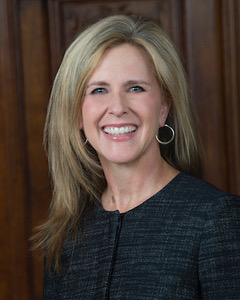Kristina Swallow, P.E., ENV SP, F.ASCE is the current president of the American Society of Civil Engineers (ASCE). She is a civil engineering leader with more than 20 years of professional practice in water resources, transportation, and land development. Among her many past roles, she served as Region 8 Director, Region 8 Governor, Chair of the Education Activities and the Diversity and Women in Civil Engineering committees, and ASCE’s 150th Anniversary Steering Committee.
Kristina has a diverse professional background that includes serving as a program manager in the capital improvements division for the City of Las Vegas, as a transportation policy advisor for a U.S. Senator in Washington, DC, and working as a land development consultant in the fastest growing city in the United States, including five years as a small business owner.
She is passionate about civil engineering and the benefits of infrastructure for communities, especially transportation systems.
ASCE’s Infrastructure Report Card: Tool to Raise Awareness
We didn’t get here to the state of our current infrastructure overnight. It took us decades. It took us a generation to get here. The report card obviously is a tool to help convey the condition so everybody understands what we’re talking about and the impact on our lives. While we’ve been doing it now for some time, it has taken time to build that momentum, to build the understanding so that, today, it is being regularly used as a communication point and regularly used to help drive the conversation at all political levels: at the state, federal and local levels.
Reasons for Optimism: Infra Support at High Levels
On the bill and infrastructure package that the president released, we were and are optimistic in that we have a president who is talking about infrastructure investment as a driver for our economy and has actually taken a step to deliver a package to lay out his plan or his thoughts on how we might invest in infrastructure. As a result, we’re optimistic that he’s talking about it, he’s pushing it forward. It was, at least at the time, a priority for him. The basis of the optimism is that there is something out there, there is a package and there is good discussion going on about it.
The Challenge: Moving from Broad Support to Real Action
The good news on the public engagement is that, generally, the public supports increased infrastructure investment. They understand the impact on their lives. They understand that when we invest in infrastructure it actually helps their personal pocket book, but it also helps their quality of life. There is support there. The challenge is getting infrastructure into a place where it’s being acted on, where we can start to push forward or we can start to have that conversation and really get the investment happening at the federal level.
The Public Plays a Huge Role in Shaping Infra Policy
The role of citizens is huge. Whether it’s engineers, because we know exactly the impact of the infrastructure and the challenges of the infrastructure; or my parents, or my brother and my sister, we citizens help drive priorities of Congress. Having worked there, it’s very clear that when the public says it’s time to invest, investment happens…We’ve seen that with infrastructure, again, at the state and local level when there’s a failure, all of a sudden the public comes out and they say, “This doesn’t work and you have to fix this.” The politicians do prioritize, so the public has a huge rule in helping shape priorities of our elected leaders.
Why Transportation Often Tops the List
Transportation is the one piece of infrastructure that I feel the public interacts with the most and understands the most. Our drinking water system, our waste water systems: we rely on them and they’re something that we just expect to work. And as long as they do work we’re fine, but when we get on the road or get on the train, or get on the transit or the bus, when we get out of our houses and start going to work, school, play, we feel the impact of the transportation system so critically. Because of that, we’ve seen over half of the states increase their fuel tax because the public has been pushing and they’ve been saying, “You need to fix this.”
Funding Transportation: Increasing the Fuel Tax
The Highway Trust Fund is underfunded and it’s the largest piece of the infrastructure deficit that we see on our report card. Of the two trillion dollars additional investment needed in the next ten years, one trillion of that is in surface transportation. The quickest, easiest way to increase that investment is an increase in the fuel tax and an increase in the federal fuel tax…There are challenges with that, long term. We fully recognize that and are supportive of other funding mechanisms being developed to ultimately transition as fuel tax changes as we start to have more fuel-efficient cars or even alternative energies, looking at the electric vehicles.
Tags: American Society of Civil Engineers, ASCE, Infrastructure Report Card, Kristina Swallow, Report Card on America's Infrastructure, The Infra Blog







 RSS Feed
RSS Feed